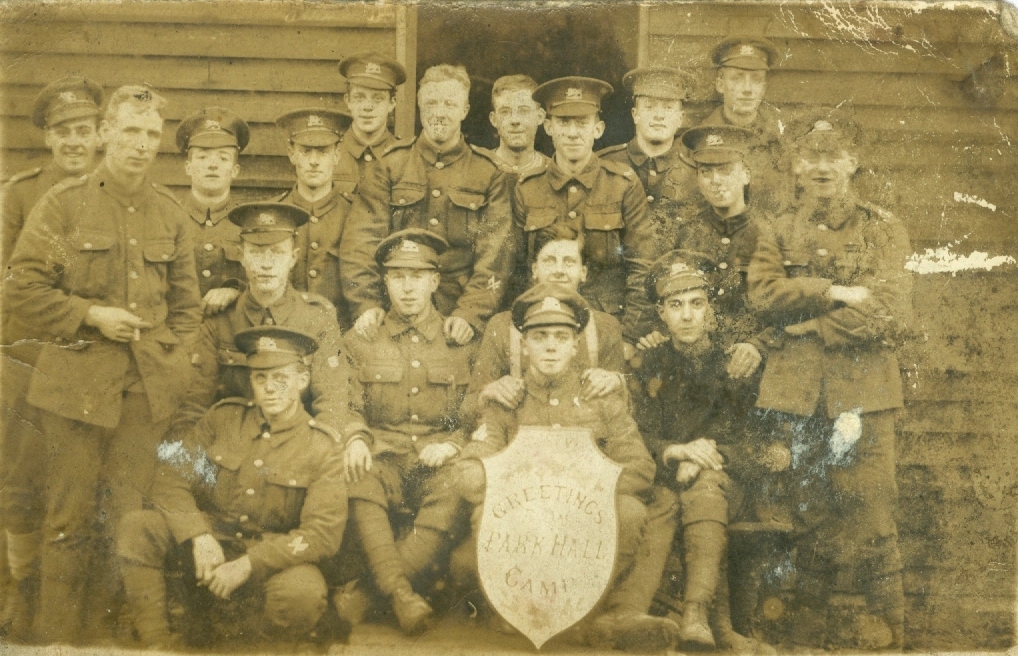
Wilfred or Ben Lamb training at Park Hall Camp"
Park Hall Camp, Oswestry
1915
It is either Wilfred or his brother Ben on this photo. Bearing in mind the account below, it is more likely to have been Ben.
Ben was in the Royal Welch Fusiliers and Wilfred was in the Lincolnshire Regiment.
Ben went to Wrexham to enlist, probably on account of his age; he is therefore recorded on a plaque in Saint Giles' Church rather than in Buckley. He served in Waziristan where there was a campaign waged by British and Indian forces against the Mahsud Tribe in 1919 - 1920.
***********************************
from Wikipedia
Waziristan Revolt (1919-1920)
In the rugged and remote region of Waziristan on British India's northwest border with Afghanistan, mountain tribes of Muslim fighters gave the British Indian Army a difficult time in numerous operations from 1860 onwards.
The Waziristan Revolt of 1919-1920 was sparked by the Afghan invasion of British India in 1919. Though the British made peace with the Afghans, the Waziri and Mahsud tribesmen gave the imperial (almost entirely Indian) forces a very difficult fight. Some of the tribesmen were veterans of the British-organised local militias that were irregular elements of the Indian Army (Pakistan did not exist at this time), and used some modern Lee-Enfield rifles against the Indian forces sent into Waziristan. One aspect of this conflict was the effective use of air power against the Waziris and Mahsuds. This is similar to Royal Air Force tactics in suppressing the Arab Revolt in Iraq in 1920 and 1921.
**********************************
This account is taken from the shropshire-cc.gov.uk web site (June 2013)
Park Hall was one of the finest Tudor mansions in England, prior to its destruction by fire on Boxing Day, 1918. It stood about one mile to the east of Oswestry, and was built by Robert Powell towards the end of the 16th century, although the exact date is uncertain. The Hall was 126 feet long, and the main hall was 33 feet long. There was a small chapel contained in the west wing, with stained glass windows and an oak panelled ceiling. The house itself contained much fine furniture and paintings, many of which were displayed in the long gallery, extending nearly the entire length of the house.
Through various childless marriages, the estate passed from family to family until in 1870 it was bought by Mrs. Wynne Stapleton Cotton, later to marry her second husband, Alfred Wynne Corrie, and become Mrs Wynne Corrie.
With the advent of the First World War, Major Corrie moved into Shrewsbury, and handed over the Hall to the military as their local headquarters. The First Oswestry knew of this was a small paragraph in the Border Counties Advertiser in November 1914, when it was announced that 14,000 troops would soon be arriving. Within a fortnight, the estimate had risen to 21,000 troops with 4-500 officers. Whilst this was welcomed in many quarters, the local burghers of Oswestry warned of the possible moral danger to the young ladies of the area! Although it had been a wet and miserable winter, by Spring of 1915, over 900 labourers were busy constructing the camp in the grounds of the old Hall. In July 1915, the first 4,000 troops of the Royal Welch Fusiliers and the Cheshire regiment arrived at the Hall. They disembarked at Whittington Station and marched to the camp with the Fusilier's mascot, the goat, talking the lead. The camp was in constant use throughout the war, training and dispatching troops to the Front.
Author: Smallwood, Barry
Tags
Year = 1915
Building = Military
Gender = Male
People = Group
Work = Military
Extra = Formal Portrait
Extra = WW1
Extra = 1910s
Copyright © 2015 The Buckley Society
